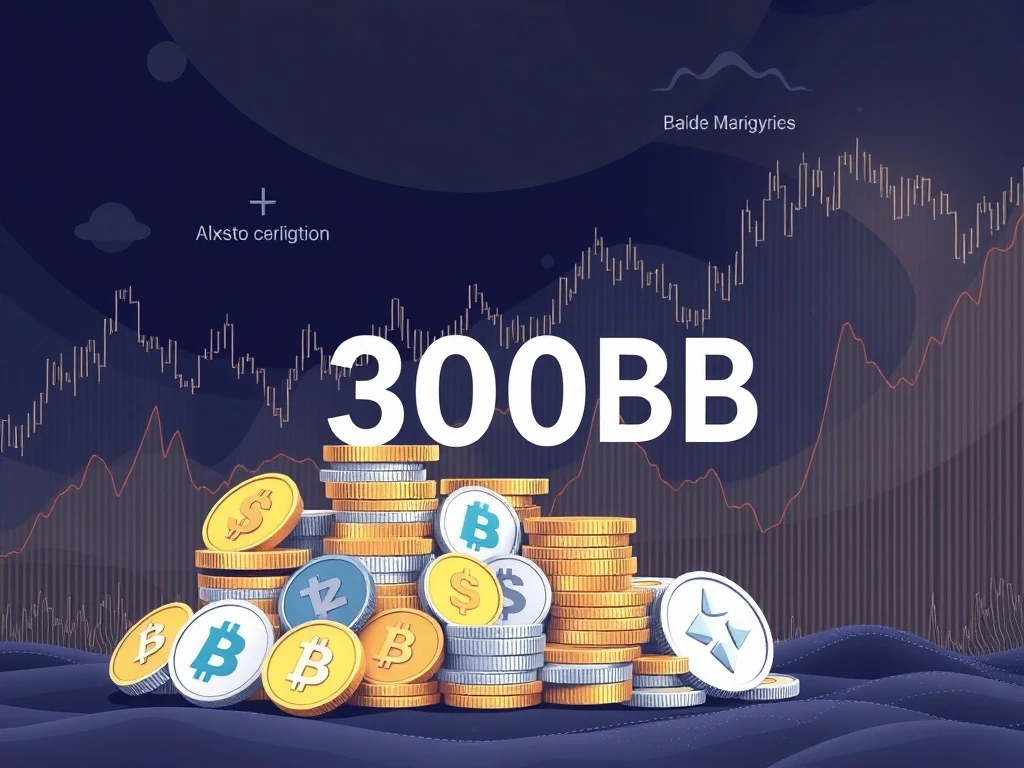Stablecoin Market Cap Soars to $300 Billion: Unpacking the Discrepancies and Future of Digital Currencies

The cryptocurrency world recently witnessed a truly significant milestone. The stablecoin market cap officially surpassed the $300 billion mark. This incredible growth highlights their increasing importance within the global digital economy. However, a closer look reveals a complex picture. Leading crypto data platforms, such as CoinMarketCap, CoinGecko, and DefiLlama, show differing figures. This prompts crucial questions about how we measure this rapidly expanding sector and its path to widespread adoption.
Understanding the $300 Billion Stablecoin Market Cap Milestone
The stablecoin sector has truly flourished in recent years. On a recent Thursday, CoinMarketCap (CMC) reported that the total stablecoin market cap reached an impressive $300 billion. This figure represents a monumental achievement for digital assets designed to maintain a stable value. These assets are typically pegged to traditional currencies like the US dollar or to commodities such as gold. They offer crucial stability in the often-volatile crypto markets. Consequently, stablecoins have become essential tools for trading, lending, and cross-border remittances. The market’s rapid expansion is undeniable, reflecting growing institutional and retail interest in these reliable digital instruments.
Why Crypto Data Platforms Show Different Numbers
Despite the exciting milestone, discrepancies persist across various tracking platforms. CoinGecko, for instance, reported $291 billion for the stablecoin market cap. DefiLlama showed $289 billion around the same time. These differences are not minor; they highlight a fundamental challenge in accurately tracking decentralized digital assets. Rafaela Romano, an ambassador at the crypto analytics platform Alphractal, explained why these variations “will always exist.” Each platform applies distinct methodologies when calculating market caps. “With Bitcoin, it is relatively straightforward to calculate supply and market cap,” Romano stated. “But with other blockchains, projects, and new tokenomic models, things quickly become more complex.” This inherent complexity is at the heart of the issue, creating diverse reporting.
Unpacking Diverse Methodologies for Market Capitalization
Different approaches inevitably lead to varied results in reported market capitalization. CMC tracks approximately 150 stablecoins, focusing on a curated list. In contrast, CoinGecko and DefiLlama report data for a significantly larger number, roughly 300 stablecoins each. This disparity in the scope of tracked assets is a major factor. Alphractal’s Romano noted that CMC usually does not disclose per-stablecoin calculation details transparently. CoinGecko, however, aggregates data from many exchanges. It employs sophisticated tools such as volume-weighted algorithms and outlier detection to measure reliability accurately. DefiLlama emphasizes on-chain Total Value Locked (TVL) and sources token pricing from CoinGecko’s API. Consequently, DefiLlama’s figures often align closely with CoinGecko’s. These distinct strategies directly influence the reported total.
Specific Examples of Stablecoin Data Discrepancies
Several concrete examples further illustrate these tracking challenges among crypto data platforms. New blockchain integrations are a primary source of divergence. Romano pointed out that newly issued smart contracts can be omitted, causing temporary inaccuracies. The technological complexity of certain networks also contributes to delayed or incomplete data. For instance, while CMC reports a larger overall market cap, it does not include Tether Gold (XAUT) in its tracked stablecoin count. CoinGecko, however, does include XAUT. This single difference creates a $1.3 billion divergence. Furthermore, CMC had not yet integrated the new Sky (USDS) contract, which is an upgraded version of DAI. CoinGecko, conversely, already included it, leading to another significant $8.1 billion discrepancy. Such examples clearly underline the nuances of data aggregation in this dynamic sector.
CoinMarketCap’s Approach to Rehypothecated Assets
CoinMarketCap employs a specific classification system that impacts its reported figures. Alice Liu, CMC’s head of research, clarified their methodology for Crypto News Insights. CMC separates tokens backed by crypto assets or involving complex collateral structures from those primarily backed by fiat currency. These more intricate tokens are categorized as “rehypothecated assets” rather than standard stablecoins. Liu explained that this distinction ensures collateralized value is not counted multiple times across different categories. “For example, wrapped assets, staking or restaking derivatives, and tokens like USDS fall into this group,” she stated. This deliberate classification aims for greater clarity and accuracy within their specific framework, ultimately influencing their reported market capitalization.
The Critical Role of Stablecoins in the Crypto Ecosystem
Stablecoins have become truly indispensable components of the cryptocurrency ecosystem. They act as a crucial bridge between traditional finance and the decentralized digital world. Their stable nature allows traders to lock in profits or mitigate risk without fully exiting the crypto ecosystem. Furthermore, they facilitate efficient cross-border payments, often with lower fees and faster settlement times than traditional banking. Moreover, stablecoins power a vast array of decentralized finance (DeFi) applications, serving as the base currency for lending, borrowing, and yield farming. Without stablecoins, the crypto market would face even greater volatility and reduced utility. They provide essential liquidity and a reliable store of value, making them foundational for many digital financial services. Their continued growth directly impacts the stability and functionality of the entire industry.
Navigating Regulatory Landscapes and Mainstream Adoption
The journey towards widespread mainstream adoption for stablecoins continues to evolve. The year 2025 has seen stablecoins emerge as one of the key industry trends. This is partly due to the Trump administration’s explicit efforts to promote stablecoins, aiming to strengthen the US dollar’s global standing. The US’s adoption of the Genius Act in July further supports this push, signaling a more structured approach to digital asset regulation. After surpassing a $200 billion market cap in late 2024, the stablecoin market’s growth has only accelerated. However, significant barriers to widespread public use remain. Chris Robins, Axelar’s head of growth, noted that $300 billion is still an “early milestone” in the grand scheme of global finance. Stablecoins are yet to achieve the kind of universal acceptance seen by traditional currencies.
Key Drivers of Stablecoin Market Growth
The rapid expansion of the stablecoin market cap is largely attributable to the performance and utility of a few dominant players. Tether USDt (USDT) remains a powerhouse, consistently holding the largest share of the market due to its early mover advantage and widespread exchange support. Circle’s USDC (USDC) also contributes significantly, often favored by institutional investors and for its regulatory compliance focus. More recently, Ethena Labs’ yield-bearing stablecoin USDe (USDE) has seen remarkable growth, appealing to users seeking innovative yield opportunities within the crypto space. These assets offer diverse use cases and attract different user bases, from retail traders to large financial entities. Their combined success and continuous innovation propel the overall market forward, demonstrating the utility and demand for stable digital assets.
Hurdles to Mainstream Stablecoin Adoption
Despite the positive trajectory, several significant obstacles persist on the path to mainstream adoption. A senior analyst at Glassnode highlighted some remaining barriers. Regulatory concerns from powerful bodies like the European Central Bank (ECB) are prominent. The ECB has expressed caution regarding potential systemic risks posed by large stablecoin projects, as well as concerns about consumer protection and financial stability. Additionally, issues surrounding stablecoin transparency remain a critical point of contention. Users and regulators demand clear, verifiable audits and robust reserve management to ensure true stability and trustworthiness. Addressing these concerns is vital. It will pave the way for greater public trust and broader acceptance, requiring clear regulatory frameworks and robust oversight to mitigate risks and foster innovation responsibly.
The Future Trajectory of Stablecoins and Market Capitalization
Projections for stablecoin growth are overwhelmingly optimistic. Some analysts anticipate the stablecoin market cap could reach an impressive $400 billion by late 2025. This projected growth hinges on several critical factors. Continued regulatory clarity and harmonization across jurisdictions would certainly help reduce uncertainty and encourage broader institutional participation. Technological advancements, especially in cross-chain interoperability and scalability, are also crucial for expanding stablecoin utility. Furthermore, increased institutional participation from traditional financial firms could provide a significant boost, as more explore digital assets. Stablecoins offer a stable and familiar entry point for these entities. The evolution of crypto data platforms will also play a pivotal role in accurately tracking and verifying this growth, providing essential insights for the market.
The Evolving Role of Crypto Data Platforms in a Growing Market
The role of crypto data platforms will only grow in importance as the stablecoin market matures. Accurate and transparent data becomes paramount for investors, regulators, and developers alike. These platforms need to constantly refine their methodologies, adapting to new stablecoin designs, diverse collateral structures, and the rapid pace of blockchain integrations. Clear and consistent communication about their calculation methods, including any unique classifications like CMC’s “rehypothecated assets,” is also essential. This transparency builds trust among users and analysts, fostering a more informed ecosystem. Ultimately, reliable data helps investors make sound decisions, assists regulators in understanding market dynamics, and supports the overall health and credibility of the stablecoin sector. Their continuous innovation is as vital as the stablecoins themselves.
Conclusion: A Stable Future for Digital Finance?
The stablecoin market cap reaching $300 billion marks a pivotal moment in the evolution of digital finance. It signals the growing maturity and undeniable importance of these stable digital assets within the global financial landscape. While the existing discrepancies among crypto data platforms pose challenges, they also drive continuous innovation in data tracking and methodology. Overcoming regulatory hurdles, enhancing transparency, and improving user experience are crucial steps for the sector. These efforts will unlock the full potential of stablecoins for true mainstream adoption. The journey ahead promises further growth, integration, and a profound impact on how we conduct transactions and manage value globally. Stablecoins are undoubtedly shaping the future of finance, offering a glimpse into a more stable and efficient digital economy.









